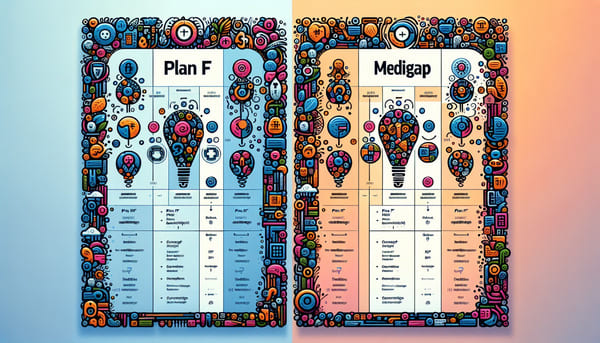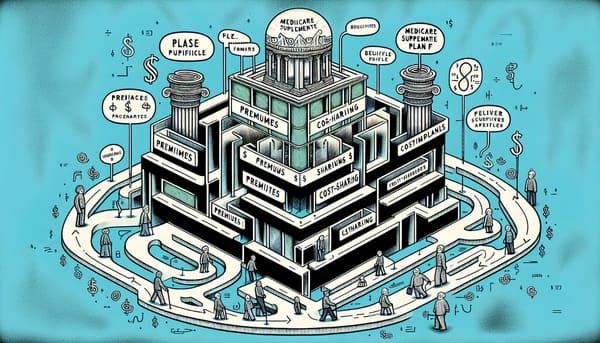
by Russell Noga | Updated March 23rd, 2024
If you’re looking for current information on Medicare Supplement Plan F 2025, you’ve come to the right place. This article cuts through the complexity to provide you with what has changed, what remains, and how to get the most out of Plan F for the upcoming year. Stay informed on eligibility, coverage, and cost considerations to manage your healthcare needs confidently in 2025.
Key Takeaways
- Medicare Supplement Plan F offers extensive coverage and remains available only to beneficiaries who became eligible for Medicare before January 1, 2020, as a result of the Medicare Access and CHIP Reauthorization Act of 2015.
- Plan F provides a high-deductible option for cost-conscious individuals and covers all Medicare Part A and B services after the deductible is met, differing from other plans like Plan G, which does not cover the Part B deductible.
- Premiums for Plan F vary based on multiple factors, including age, location, and insurer pricing methods, and while the plan minimizes out-of-pocket costs for covered services, premiums generally experience an annual increase.
Compare 2025 Plans & Rates
Enter Zip Code
Understanding Medicare Supplement Plan F in 2025

Medicare Supplement Plan F is a stalwart among Medigap policies designed to fill the gaps left by Original Medicare. With a reputation for offering the most extensive coverage, Plan F has long been a preferred choice for Medicare beneficiaries, seeking peace of mind and financial predictability.
Yet, as we venture into 2025, it’s crucial to reexamine this plan in light of recent changes and ongoing healthcare trends.
Eligibility and Enrollment for Plan F
Diving into the eligibility criteria, not all who wander the halls of Medicare can claim the bounties of Plan F. Only those who became eligible for Medicare before January 1, 2020, can enroll in this plan. This temporal gateway has left many newer Medicare beneficiaries yearning for the comprehensive coverage that Plan F provides. Furthermore, for individuals under 65 with disabilities, eligibility hinges on their state’s Medigap enrollment policies and the critical cutoff date.
The golden time to embark on the Medigap journey is during the Medigap Open Enrollment Period. This six-month window, commencing when a beneficiary turns 65 and is enrolled in Medicare Part B, is a precious opportunity to secure a Medigap policy sans medical underwriting. Unlike the annual enrollment periods for Medicare Advantage, this is a once-in-a-lifetime offer that doesn’t repeat each year.
Key Benefits of Plan F Coverage
Plan F is renowned for its shield of protection against various expenses. The plan fully covers the Part B deductible, ensuring that once Medicare-approved amounts for covered services are billed, the calendar year deductible is met. Additionally, the Part A deductible for hospitalization is absorbed by Plan F, providing coverage from the onset of inpatient service and extending 60 consecutive days post-hospital stay.
On the battlefield of major medical events, Plan F is the knight in shining armor, offering an additional 365 days of coverage after Medicare Part A hospital benefits are exhausted at no extra cost to the beneficiary. It also empowers beneficiaries with the freedom to choose their healthcare provider across the United States, sans referrals, making it a great alternative to a Medicare Advantage Plan. While Plan C is another option, Plan F remains a popular choice for comprehensive coverage.
Changes to Plan F in 2025
As the tides of healthcare legislation ebb and flow, Plan F has not been impervious to change. The Medicare Access and CHIP Reauthorization Act of 2015 (MACRA) brought a significant amendment, barring new Medicare beneficiaries, those eligible after January 1, 2020, from purchasing Medigap plans that cover the Part B deductible, including Plan F. This legislative turn has undoubtedly reshaped the Medigap landscape, compelling beneficiaries to seek alternative solutions.
Comparing Plan F to Other Medigap Policies

As we wade deeper into the realm of Medicare, comparing Plan F with its kin reveals its unique stature. Plan F is the only Medigap policy that envelops the Part B deductible within its coverage, setting it apart from the pack. It also fully covers Part B excess charges, a benefit that most other Medigap plans do not offer, ensuring beneficiaries are shielded from additional costs.
While mirroring other plans in covering Part A coinsurance, Part B coinsurance or copayments, and the blood benefit, Plan F does not cap an out-of-pocket limit like Plans K and L but instead offers more comprehensive coverage upfront. The plan also provides complete coverage for the Part A deductible and skilled nursing facility care coinsurance, unlike Plans A, M, K, and L, which offer partial or no coverage for these costs. Additionally, Plan F includes provisions for foreign travel emergency coverage, a boon not universally available across all Medigap plans.
Plan F vs. Plan G: A Detailed Review
When pitting Plan F against Plan G, the champions of coverage, a fine line separates them. Both plans are generous in their offerings, covering:
- Part A coinsurance and hospital costs
- Part B coinsurance or copayments
- Skilled nursing facility care coinsurance
- Part B excess charges
- Foreign travel emergency care
However, the crux lies in the coverage of the Part B deductible; Plan F covers it fully, while Plan G does not.
Thus, the deciding factor between these titans often boils down to whether the coverage of the Part B deductible under Plan F justifies any potential differences in premium costs compared to Plan G. This consideration beckons a careful weighing of personal healthcare needs against financial readiness.
High Deductible Option for Plan F
For those drawn to the allure of lower premiums, the high-deductible version of Plan F might be a compelling alternative. This option requires beneficiaries to foot a predetermined amount in out-of-pocket costs before their policy coverage kicks in. Once the high deductible is met, Plan F unfurls its protective wings, covering 100% of Medicare Part A and B services for the remainder of the year.
While Medicare continues to pay its share, typically 80%, for covered services, the high-deductible Plan F beneficiary covers the remaining costs up to the deductible. The specific deductible amount is subject to annual adjustments, often based on the Consumer Price Index (CPI-U) percentage increase.
High deductible Plan F may appeal to:
- cost-conscious individuals
- individuals who are comfortable with higher out-of-pocket expenses
- individuals with robust retirement savings
- individuals with past experience with high deductible health plans.
Compare Medicare Plans & Rates in Your Area
Financial Aspects of Medicare Supplement Plan F

Navigating the financial seas of Medicare Supplement Plan F reveals that its premiums are influenced by a constellation of factors, including:
- Age
- Location
- Tobacco use
- The specific pricing methods of insurance companies
Though the average premium hovers around $250 per month, the actual cost can vary significantly based on individual circumstances.
Plan F’s comprehensive coverage, encompassing Part A and B deductibles, coinsurance, and copayment, significantly reduces out-of-pocket expenses for beneficiaries.
Understanding Premiums and Cost-Sharing
The premiums for Medicare Supplement Plan F are as varied as the people they serve, influenced by each insurance company’s unique pricing methodology. While the benefits of Plan F are uniform across insurers, premiums can differ markedly for the same coverage. Discounts on premiums may be offered based on a variety of factors, including gender, smoking status, and payment methods.
Medigap policyholders, in addition to their Medicare Part B premium, must pay a private insurance monthly premium that typically sees an annual increase. It’s vital for beneficiaries to be vigilant, tracking their medical expenses to ensure they are not overpaying after meeting their deductible. With premiums subject to change each year and insurers occasionally discontinuing plans, beneficiaries must be proactive in managing their Medigap coverage.
Analyzing Out-of-Pocket Costs with Plan F
For those who choose Plan F, the journey through healthcare expenses typically entails few surprises, as the plan is designed to minimize out-of-pocket costs for Medicare-approved services, excluding the plan’s premium. It offers comprehensive coverage for Medicare covered services such as:
- The Part A hospital deductible
- The Part B outpatient deductible
- The 20% coinsurance that Medicare Part B doesn’t cover
- Any standard 15% excess charges for Part B services.
By covering these costs, Plan F ensures that its policyholders are insulated from unexpected medical bills.
How to Switch to Plan F or Change Plans

Mulling over a switch to Medicare Supplement Plan F or contemplating a change from it is like contemplating a new course on a well-trodden path. Beneficiaries can switch to Plan F or change from it by reaching out to their Medigap insurance company, and they may choose from any Medigap Plan A, B, K, or L sold in their state, provided they find an insurer willing to sell them a policy. However, it’s important to note that once a beneficiary drops their original Medigap policy, they might not be able to re-enroll in it.
When to Consider Switching Plans
Life’s vicissitudes often prompt a reassessment of one’s Medigap policy. Beneficiaries might find themselves at a crossroads, considering a switch if their current plan no longer aligns with their health needs or financial situation. A change in health status, such as the onset of a new medical condition not fully covered by their present plan, could steer beneficiaries towards a plan offering more comprehensive benefits.
The Enrollment Window and Deadlines
Navigating the enrollment windows and deadlines for switching Medigap plans requires punctuality and precision. Certain states offer continuous enrollment opportunities, allowing beneficiaries to enroll or switch Medigap plans at standardized rates, regardless of their age or health.
Special Enrollment Periods may arise due to significant life events, such as losing coverage involuntarily or relocating to a new area.
Impact of Recent Legislation on Plan F
The ebb and flow of healthcare legislation can profoundly impact Medigap policies, and Plan F is no exception. Following the CHIP Reauthorization Act of 2015, as of January 1, 2020, new Medicare enrollees can no longer purchase Plan F, although existing beneficiaries can maintain their coverage.
These legislative changes aim to encourage more prudent use of healthcare services by requiring all traditional Medicare beneficiaries to pay the Part B deductible.
Legislative Changes Affecting Plan F
Recent legislative changes have cast ripples across the Medigap policy pond, and Plan F has felt the waves. To mitigate biased plan steering, CMS is proposing fixed compensation amounts for agents and brokers, which could influence beneficiaries’ decisions about Plan F and other Medigap policies.
Future Proposals and Their Potential Effects
Looking towards the horizon, potential future proposals could reshape the Medigap market and impact Plan F. CMS’ proposed policies for 2025 focus on strengthening beneficiary protections, which may benefit those with Medicare Supplement Plan F. The proposals include new standards to limit out-of-network cost-sharing for specific services, which could set precedents affecting future Medigap policies and the cost-sharing dynamics of Plan F.
Maximizing Your Medicare Benefits with Plan F

Harnessing the full potential of Medicare Supplement Plan F is akin to charting a course through uncharted waters with a trusted compass. The plan covers additional costs for major medical events, such as surgery or hospitalization, ensuring financial protection during these tumultuous times.
To maximize the benefits, beneficiaries must familiarize themselves with the range of covered services and leverage the plan for maximum financial and health security.
Coordinating with Other Medicare Parts and Medicaid Services
The tapestry of Medicare is intricate, and coordinating Plan F with other Medicare parts and Medicaid services is crucial for a seamless coverage experience. CMS’ efforts to integrate Medicare and Medicaid services for dually eligible enrollees in Medicare Advantage Plans underscore the importance of comprehensive coverage, which may also influence the value proposition of Medigap plans like Plan F.
Tips for Working with Providers and Insurers
Sailing smoothly through the healthcare system with Plan F necessitates an understanding of how to navigate relationships with providers and insurers effectively. Ensuring that chosen doctors and hospitals accept Medicare and are willing to work within Plan F’s terms is paramount for maintaining coverage.
Accurate claim forms and proactive communication with healthcare providers and insurers can help clarify coverage details and prevent unexpected out-of-pocket costs.
Summary
We have journeyed through the complexities of Medicare Supplement Plan F, examining its benefits, financial implications, and strategic considerations. Armed with this knowledge, beneficiaries are better positioned to make choices that align with their health needs and financial goals. As the landscape of Medicare continues to evolve, staying informed and proactive will ensure that beneficiaries can confidently navigate the waters of healthcare coverage.
Compare 2025 Plans & Rates
Enter Zip Code
Frequently Asked Questions
What are the changes in Medicare for 2025?
Starting in 2025, Medicare Part D will limit out-of-pocket prescription drug costs to $2,000 annually, with adjustments based on inflation in subsequent years. However, this cap does not apply to out-of-pocket spending on Part B drugs.
Is Medicare getting rid of Plan F?
Yes, Medicare is phasing out Plan F for new enrollees after January 1, 2020. The new go-to plan for those eligible after this date is Plan G.
Is Plan F still available in 2025?
No, Medigap Plan F is no longer available for new Medicare beneficiaries as of 2020. If you become eligible for Medicare before 2020, you can still enroll in and maintain this plan.
Will there be any changes to the CMS rates affecting Medicare Supplement Plan F in 2025?
There are no specific changes announced for the CMS rates that would directly affect Medicare Supplement Plan F in 2025. However, it’s important to monitor any updates from CMS, as rates and policies can change annually.
What are the main benefits of Medicare Supplement Plan F?
The main benefits of Medicare Supplement Plan F include comprehensive coverage for deductibles, coinsurance, and excess charges, as well as additional hospital coverage beyond Medicare’s limits and the freedom to choose any doctor that accepts Medicare. These benefits provide extensive financial protection and healthcare flexibility for beneficiaries.
Speak to the Professionals about Medigap Plans and Original Medicare
If you find understanding the benefits involved with Original Medicare and Medigap Plans challenging, you’re not alone. Whether it’s a Medigap plan, or you want to know more about the Medicare Supplement Plan F in 2025, we can help. Call our team at 1-888-891-0229 for a free consultation or complete the contact form on this site, and an expert will call you back at a convenient time.
We have decades of experience advising our clients on the complexities of Medicare and Medigap plans, the benefits, cost and deductibles. We’ll ensure you get the best rate in your state and advice you can trust.

Russell Noga is the CEO and Medicare editor of Medisupps.com. His 15 years of experience in the Medicare insurance market includes being a licensed Medicare insurance broker in all 50 states. He is frequently featured as a featured as a keynote Medicare event speaker, has authored hundreds of Medicare content pages, and hosts the very popular Medisupps.com Medicare Youtube channel. His expertise includes Medicare, Medigap insurance, Medicare Advantage plans, and Medicare Part D.


